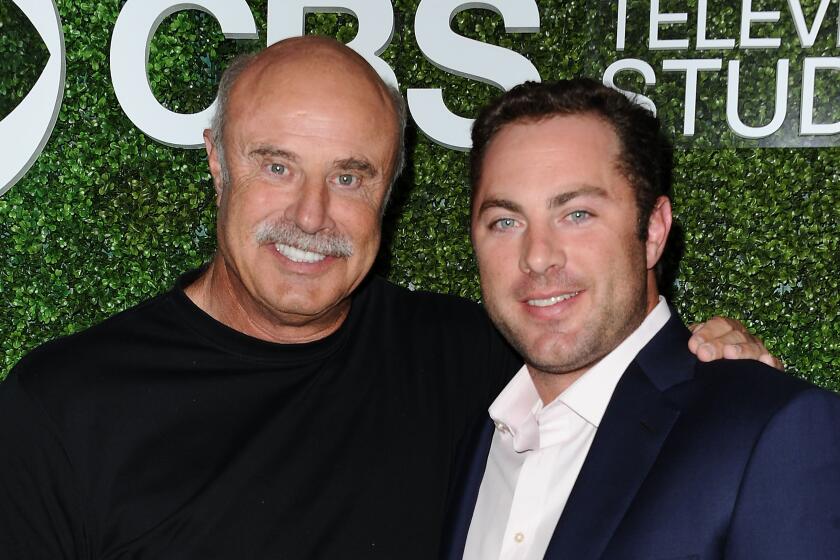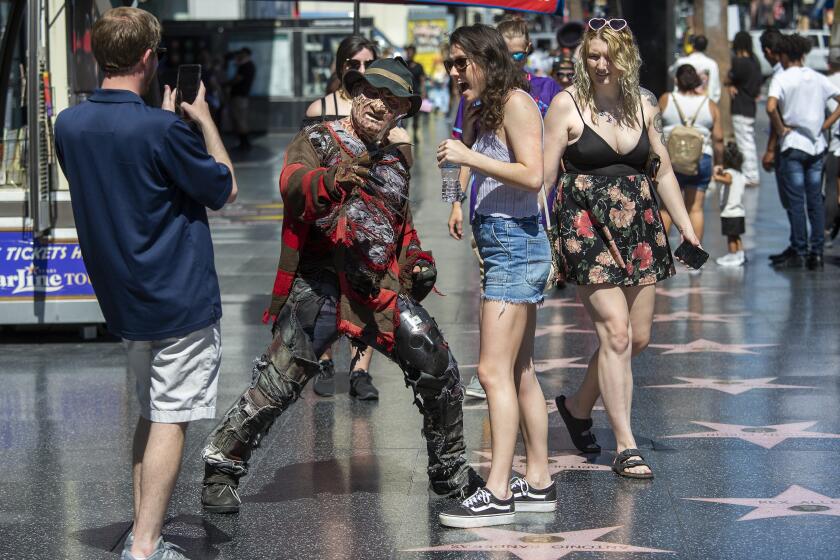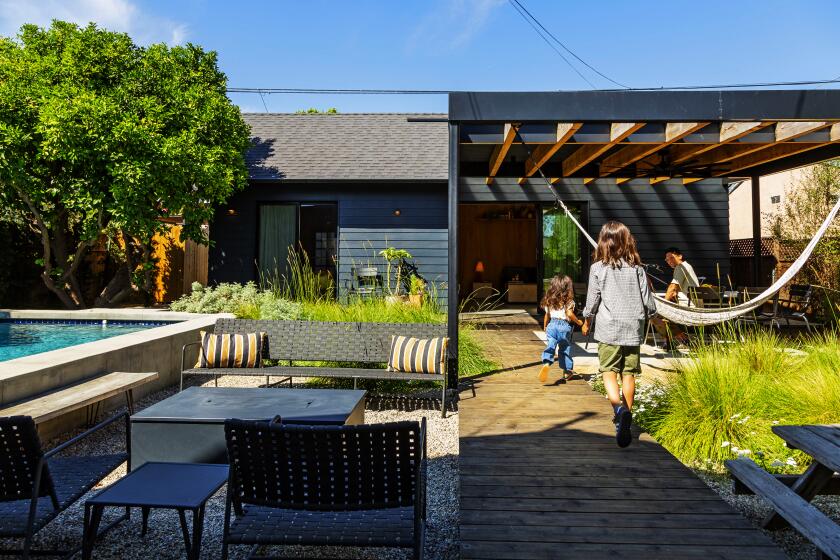The Hollywood & Highland elephants are coming down, a rejection of D.W. Griffith’s racist legacy
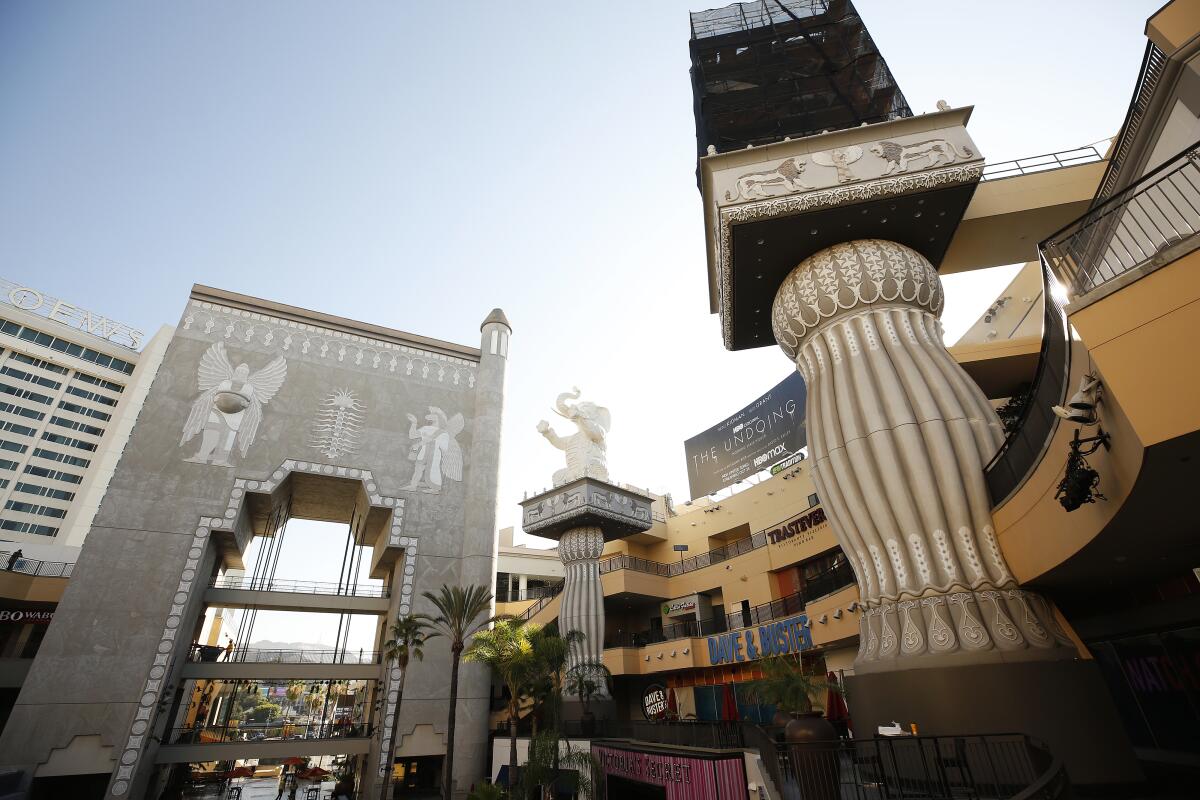
- Share via
The giant white elephants at tourist magnet Hollywood & Highland are being quietly removed as new owners update the famous shopping center where the annual Academy Awards are held and shed references to the movie industry’s past — features that revive memories of racism and sexual exploitation.
Crews on Thursday night began dismantling two giant white fiberglass elephants, which are part of the complex’s tribute to the Babylon set of D.W. Griffith’s 1916 movie “Intolerance.” All of the faux Mesopotamian elements will be taken out or altered in favor of a design developers hope will be more timeless as part of a $100-million makeover of the mall announced last year that is set for completion next summer.
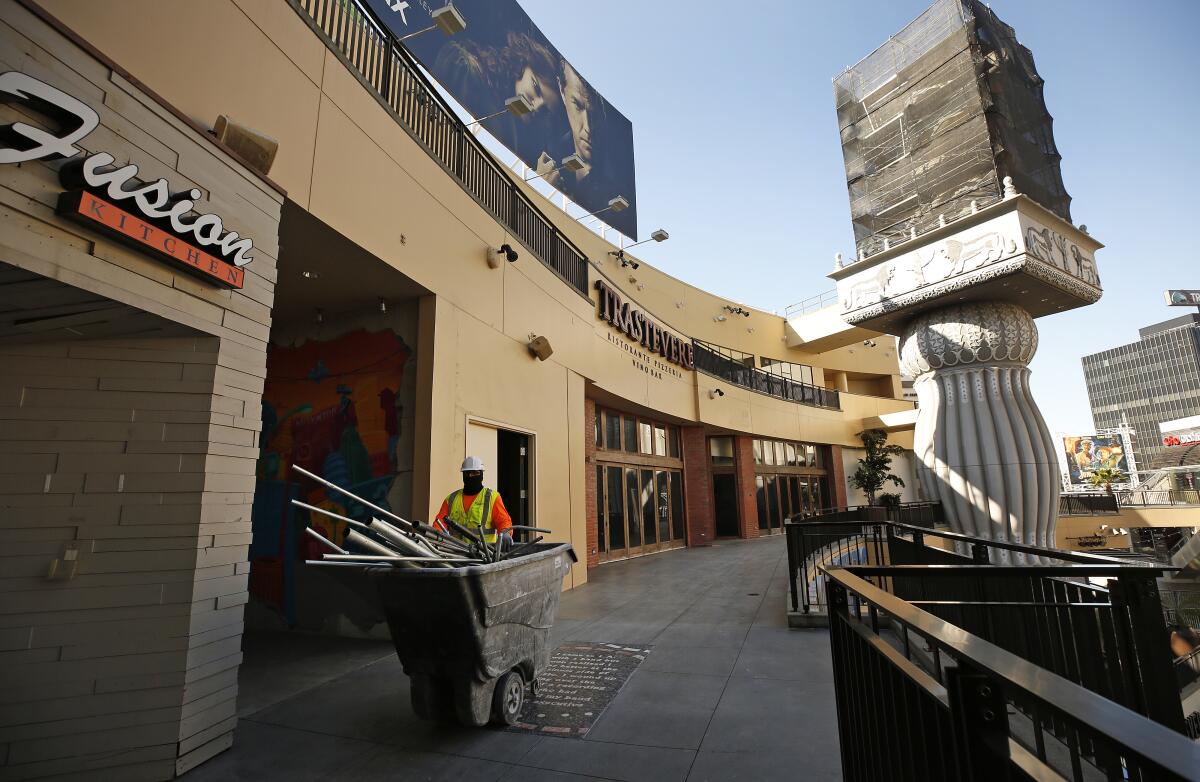
The new owners are converting much of the tourist-centric center to offices for rent and trying to make it more appealing to locals with voguish restaurants and comfortable spots to linger over coffee. That transformation includes erasing the homage to Griffith, a silent movie pioneer who directed one of the most racist films in Hollywood history.
Griffith, the son of a Confederate army colonel, directed the blockbuster 1915 film “The Birth of a Nation,” which lionized the Ku Klux Klan and was condemned at the time as “three miles of filth” by the NAACP. His follow-up film, “Intolerance” is often considered to be Griffith’s response to criticism of “The Birth of a Nation.”
Ian Smith, former host of “The Doctors,” alleges that he was brought back to the show after George Floyd protests but was soon fired by producers after complaining about racially insensitive remarks.
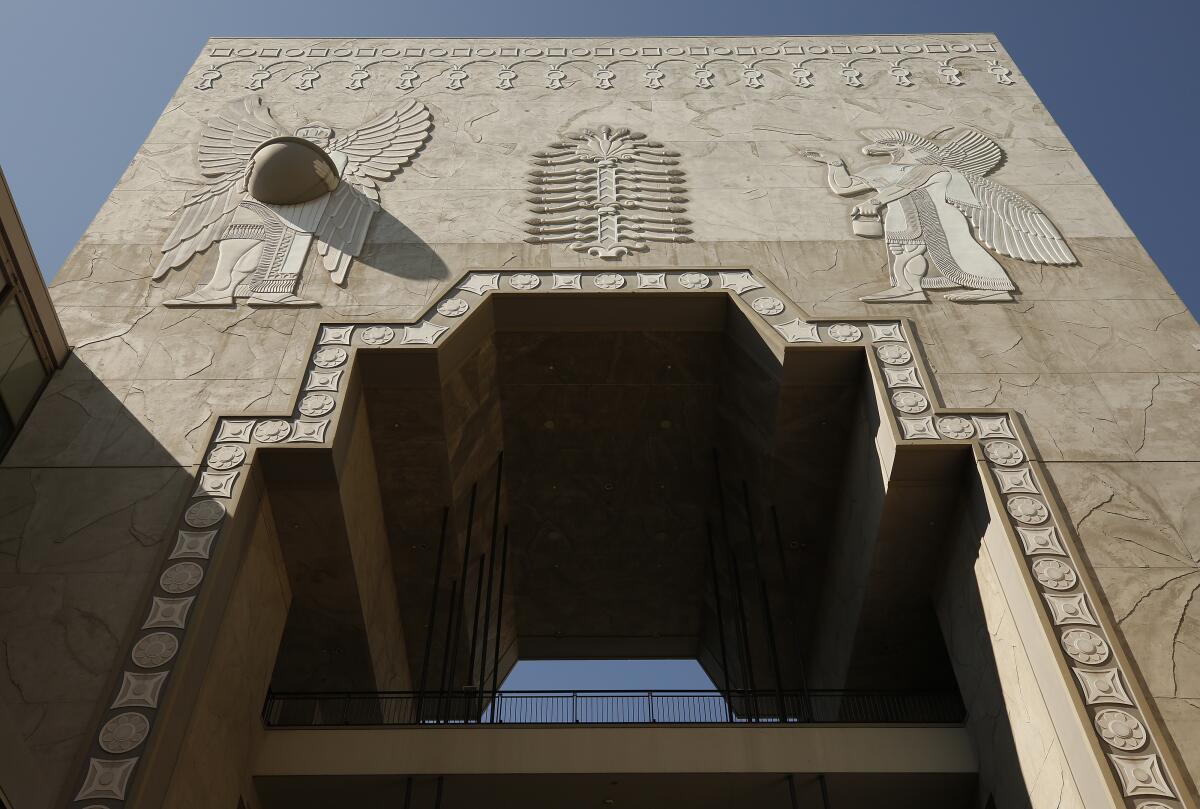
Removing references to a century-old film is part of the owners’ plan to modernize the center that opened in 2001 at the intersection of Hollywood Boulevard and Highland Avenue and anchors a tourist zone that includes the famous TCL Chinese Theatre next door where movie stars’ footprints are enshrined in concrete.
“This is a real opportunity to move away from the clichés of Hollywood, red velvet ropes and big studios,” said Chad Cress, chief creative officer for co-owner DJM. “The Hollywood of the future really needs to stand for something that is more inclusive of what our culture looks like today.”
Big studios remain “extremely important,” he said, but now the process of making entertainment is more democratic as people create content for such outlets as YouTube, TikTok, Instagram and other platforms.
“We want to celebrate the fact that we are all creatives,” Cress said.
Next year the complex will be renamed Ovation Hollywood, meant to signal that it is a place to find entertainment and culture. A prominent arch with Babylonian images will be converted to a modern take on Art Deco style with murals of people performing before lights and cameras on one side and a crowd applauding on the other.
Also getting banished is a large fiberglass sculpture of a daybed on a balcony that is the pinnacle of an art installation by artist Erika Rothenberg called “The Road to Hollywood” that tells the story about how different people followed their dreams to work in showbiz.

Some thought the sculpture looked like a “casting couch” and it was temporarily relocated in 2017 in the aftermath of the Harvey Weinstein sex scandal. But it was returned after the controversy died down.
“It’s hard to look at it and imagine anything different,” Cress said. “It’s time to create new monuments for the town.”
Workers are dismembering the enormous elephant sculptures at night so that tourists and shoppers aren’t imperiled by wayward pachyderm parts. One elephant, shrouded in scaffolding and netting, was decapitated Thursday night. The work should take several days.
The original “Intolerance” set was built on Sunset Boulevard in Hollywood, where the Vista Theater now stands. Hollywood & Highland’s developers intended the replica as a tribute to Old Hollywood, without considering the implications of Griffith’s racist legacy.
Theater, tourism, dining out, shopping took big COVID hits. But the community, which defines Los Angeles in many out-of-towners’ minds, is looking up.
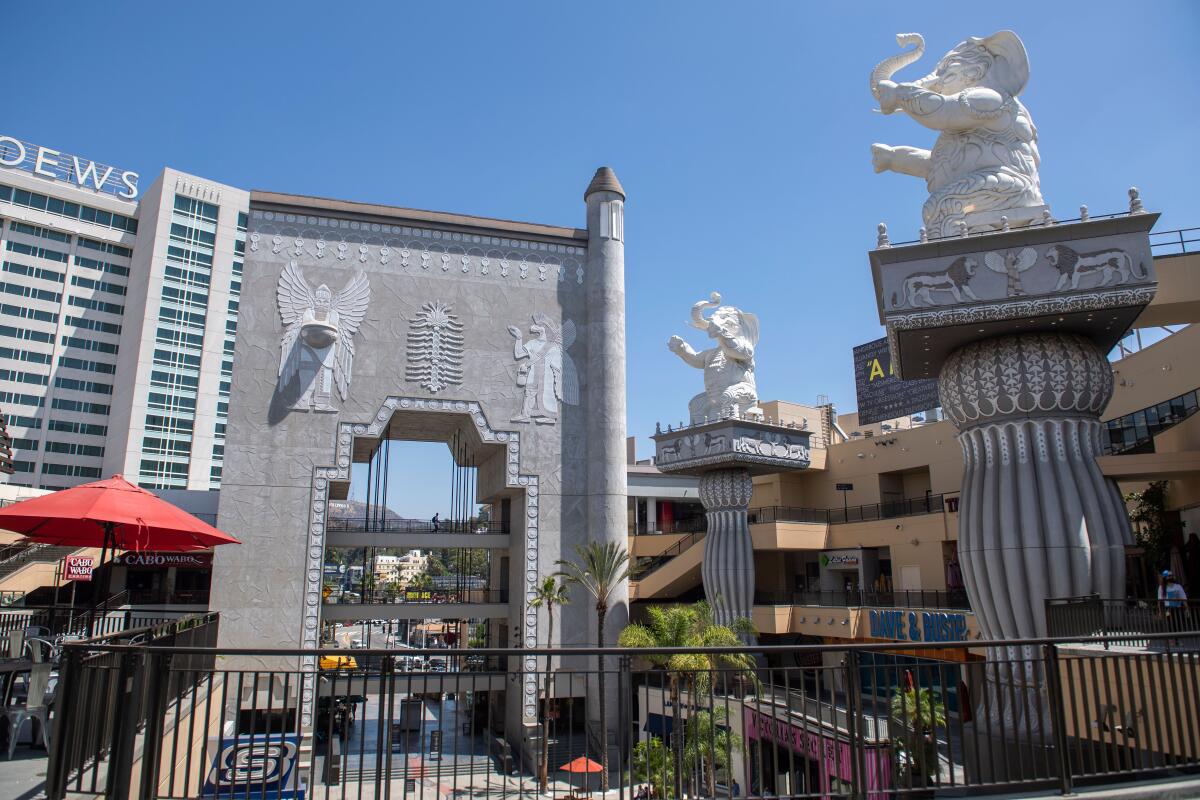
The bulk of the makeover so far has centered on converting the top two floors of the five-story mall to offices, which will bring “a major change to the energy and customer base” of the center, he said.
Cress anticipates that the main office tenant will be a media company looking for a place to broadcast in front of the backdrop of Hollywood Boulevard and interact with the public.
DJM and Gaw Capital Partners bought Hollywood & Highland for $325 million in 2019 from Los Angeles developer CIM Group. The Dolby Theatre of Academy Awards fame and adjacent Loews Hollywood Hotel were not included in the transaction.
The center needs to “pivot and transform away from being a hub of transaction to a hub of culture,” architect David Glover of Gensler said last year. Glover has since left Gensler, which remains in charge of the redesign.
Changes to the center will be both structural and cosmetic. The plan calls for a simplified facade and color scheme, more navigable layout, lush landscaping, new art pieces and expanded outdoor space to provide more opportunities to dine and linger. About a third of the center will be dedicated to food and drink.
Signs of different sizes that tend to compete with one another for attention on the boulevard will be consolidated in larger billboards in the hope of reducing clutter and presenting a more cohesive image for the property.
The surge in video-on-demand streaming has provoked “an insatiable appetite” for media-oriented real estate such as studios and offices.
Tourism is sputtering back to life, according to research by the Hollywood Partnership business improvement district. Pedestrian activity on Hollywood Boulevard is back to about 80% of what it was before the pandemic, and about 60% of the people strolling the Walk of Fame are from more than 250 miles away, according to cellphone data tracked by the district that reveals owners’ ZIP Codes.
“People show up from all over the world, and in the past it’s been a bit disappointing,” Cress said of Hollywood. “We want to create a place that represents what they had in their head. It’s a tall order.”
More to Read
Inside the business of entertainment
The Wide Shot brings you news, analysis and insights on everything from streaming wars to production — and what it all means for the future.
You may occasionally receive promotional content from the Los Angeles Times.
